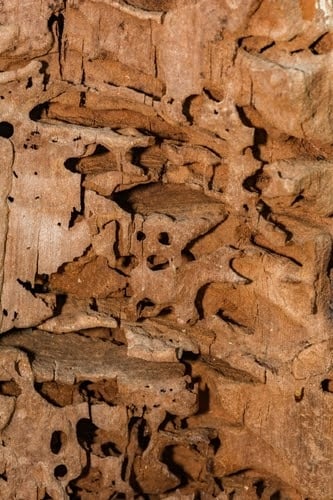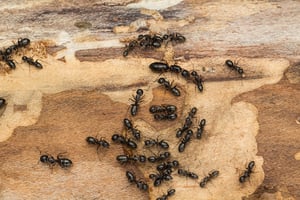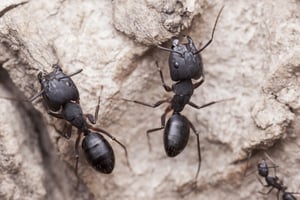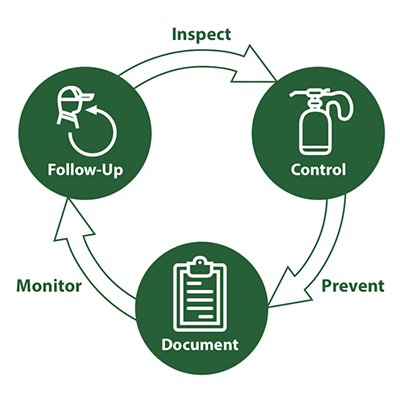Carpenter Ant Control
Do you have carpenter ants in your house? Schedule a service with Plunkett’s to keep pests out of your space!
Carpenter Ant Control in Your Area
Carpenter Ant Control in Your Area Having ants in your house isn’t just a nuisance—these pests can cause serious damage to your home and belongings. Carpenter ants typically establish their nests in moisture-damaged wood before expanding into undamaged wood, insulation, or wall voids.
If you suspect you have an ant problem in your home, it’s best to get help from professional exterminators as soon as possible.
Contact the pest control experts at Plunkett’s. We can remove an infestation and implement preventative measures.
Signs of a Carpenter Ant Infestation
Identifying an infestation early is key to preventing structural damage. Here are the most common signs of a carpenter ant problem:
- Carpenter Ant Frass (Debris). Frass is a mix of sawdust-like shavings, insect parts, and insulation fragments. Finding frass near walls, baseboards, or wood structures likely indicates an infestation.
- Carpenter Ant Galleries. Carpenter ants create smooth-walled tunnels in wood, following the grain and avoiding denser areas. Unlike termites, they remove wood rather than consume it. Galleries are often found in moisture-damaged or decayed wood, signaling potential water issues.
- Rustling Sounds in the Walls. Faint rustling or crackling noises in walls, ceilings, or furniture may indicate carpenter ants nesting. These sounds are more noticeable at night when they are most active.
- Swarming Ants (Flying Reproductives). Flying reproductive ants indoors signal an established colony. They emerge in spring and summer to mate and start new nests, often indicating a deeper infestation within your home's structure.
- Visible Ant Trails and Structural Damage. Carpenter ants frequently follow the same paths when foraging. Keep an eye out for bits of foam board insulation and signs of excessive moisture, such as peeling paint on wood thresholds, soffits, window frames, trim, and molding.
By identifying these signs early and taking preventive measures, you can protect your home from costly carpenter ant damage. If you suspect an infestation, we can help locate and eliminate nests efficiently.

What Do Carpenter Ants Look Like?
Appearance & Behavior of Carpenter Ant Types
There are three main varieties of carpenter ants, which differ in color and size, but none have stingers.
BLACK CARPENTER ANTS
Black carpenter ants (Camponotus pennsylvanicus) have workers that measure 1/4 to 1/2 inches long. They are completely black except for the fine, pale yellow “hairs” on top of their abdomen. The queens can reach ¾ inch in length.
This species is common in both rural and urban settings. It’s responsible for most of the structural damage caused by carpenter ants.

RUST-COLORED CARPENTER ANTS
Camponotus chromaiodes, or rust-colored carpenter ants, have workers that measure 1/4 to 1/2" long. Their head and abdomen are mostly black and the thorax and legs are mostly reddish. Queens measure 5/8 to 3/4" long. This species occurs more commonly in rural settings and wooded areas.

NEARCTIC CARPENTER ANTS
Nearctic carpenter ants (Camponotus nearcticus) have workers that measure 1/8 to 3/16 inches long. They can be completely glossy black or mostly black with a red thorax and legs. The queens can reach up to 5/16 inches long.
This small species is common in both rural and urban settings. Nearctic carpenter ants don’t cause as much structural damage as black and rust-colored carpenter ants.

Preventing Carpenter Ant Infestations
If carpenter ants are foraging from the outside, take these steps to keep them from invading your home:
- Seal Entry Points: Fill cracks, crevices, and gaps using silicone sealant, builder’s putty, or mortar patch.
- Trim Vegetation: Cut back tree branches and shrubs that touch your home to eliminate access points.
- Inspect Wood Sources: Regularly check logs, stumps, firewood, tree cavities, dead limbs, and loose bark for nesting ants.
- Address Moisture Issues: Fix leaks, improve ventilation, and replace water-damaged wood to deter infestations.
Our Ant Control & Removal Process
When we treat carpenter ant infestations, we follow a step-by-step process:
- We start by inspecting your building’s perimeter for foraging trails, especially in the direction of trees and shrubs.
- Carpenter ants may form a network of trails that they’ll follow throughout a structure. They often use edge lines, the tops of electrical wires, and water pipes. We’ll examine these features.
- We determine if the indoor colony is a parent or satellite colony. We do this by observing carpenter ant activity. If we find a carpenter ant trail, we follow it to the parent colony.
- If we find a colony or colonies, we treat them directly using residual and non-residual insecticides.
However large or entrenched your carpenter ant infestation, we have what it takes to remove it and prevent its return. Contact Plunkett’s today!

Carpenter Ant Control With Plunkett’s
At Plunkett’s, our goal is to help you quickly, conveniently, and in the most cost-effective way. We make every effort to be with you as soon as possible, usually within a day or two.
Not the Right Pest? Check Out These Other Ants.
There are several common varieties of ants that are likely to become pests around your home. Some of the most common examples of pest ants Plunkett’s encounters include:
Carpenter Ant Frequently Asked Questions
Do Carpenter Ants Bite?
Yes, carpenter ants can bite, but they are not aggressive toward humans. If provoked, they may use their strong mandibles to deliver a mild bite that can sometimes break the skin. Unlike some other ants, carpenter ants do not have venom, but their bites may cause slight irritation or discomfort.
How Do You Get Rid of Carpenter Ants?
To eliminate carpenter ants, their nest needs to be located and removed. This can be done by applying insecticide treatments (like liquid sprays and dusts) in key areas, and eliminating moisture sources that attract them. Carpenter ants often establish nests in hidden or hard-to-reach places, which makes professional pest control services necessary for effective removal. Plunkett’s conducts thorough inspections and applies targeted treatments to ensure complete removal. Schedule a service today!
What Do Carpenter Ants Eat?
Despite what many people think, carpenter ants do not eat wood—they tunnel through it to create nests. Their diet consists of proteins and sugars, including insects, honeydew from aphids, plant juices, and fruit. Indoors, they are attracted to household food scraps such as meats, sweets, and grease. The worker ants can travel up to 300 feet from their nest while foraging for food, making it essential to keep potential food sources sealed and inaccessible.
Are Carpenter Ants Harmful to My Home?
Yes, carpenter ants can cause significant structural damage over time by tunneling through wooden beams, walls, and furniture. Unlike termites, they do not consume wood, but their nesting behavior can weaken the integrity of a home if left untreated. A long-term infestation can lead to costly repairs, making early detection and treatment crucial.
How Did Carpenter Ants Get Their Name?
Carpenter ants get their name from their habit of hollowing out galleries in wood for nesting. This nesting behavior can cause structural damage over time.






